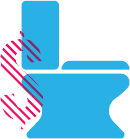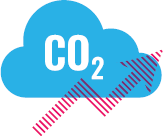
“Every company wants to invent the next
big thing. Look for product opportunities
in your biggest challenges.”
Part Two: Chapter 6
Build New Products
By Marc Kielburger
Impact through innovation: New products for the WEconomy
The savannah of Kenya's Maasai Mara is vast and beautiful. It is also home to some very dangerous creatures, most notably lions. So when you're sitting around a bonfire in the dead of night, the last thing you want to hear is something large crashing through the underbrush.
It was 2007, and Roxanne and I had invited the entire family along on our honeymoon to Kenya. As the noises drew closer, I feared we had inadvertently brought our loved ones to an untimely end. This was it—we were set to be dinner.
What emerged from the long grass was not a pack of hungry felines, but a jubilant crowd of Maasai warriors, mamas, and elders from the nearby community.
The chief stepped out from the throng. He explained that we were part of the Maasai family and needed to be married according to local custom. Speechless and a little choked up, we were placed back-to-back as the Maasai danced and sang around us. They placed grass on our shoes to symbolize that we were part of the Earth. Elders spit fermented goat's milk at our feet—not the most romantic gesture, but a sign of great respect in their culture. Roxanne was presented with an incredible collection of beaded wedding necklaces. For the Maasai, a man's wealth is measured in cattle and children, while a woman wears her wealth and experience around her neck. All of the important events in a woman's life are marked with necklaces: marriage, childbirth, grandchildren. A Maasai mama's life is written in beads.
THE WORLD'S PROBLEMS ARE INNOVATIONS WAITING TO HAPPEN.
We didn't realize it in that beautiful moment, but the Maasai had provided us with more than just a lifetime memory. They had given us a completely new perspective on business and its power to uplift lives.
Did You Know?1

40 percent of social enterprises are run by women, versus.

18 percent of traditional small and medium-sized enterprises.
As I previously shared, charities often struggle to secure stable funding. We had been searching for predictable revenue streams for ages, looking for something that would generate funds and remain consistent with the purpose of the organization. With their exquisite beadwork, the Maasai had given us both.
Entrepreneurs struggle to find new product ideas all the time. We were no exception. The Maasai taught us that some of the best ideas come from nontraditional thinking: no whiteboard or expensive consulting groups required. I'm not suggesting you need to fly to Kenya to generate new product or business solutions. But in the WEconomy, innovators need to step outside their comfort zones.
Don't just scan the Business section of the newspaper (or your favorite online news hub), read the front page.
The News and World sections are full of stories from every social and economic sector, with no shortage of intractable problems seeking innovative solutions—how many of those can be product solutions? Climate change, water scarcity, poverty … sadly, the list of problems is long. But so are the opportunities for developing solutions.
While we're on the subject of reading materials, business books will tell you about finances and accounting and management. Very few offer insights about the state of the world. Current affairs and business are not separate subjects. The world's problems are innovations waiting to happen. Look for titles that explore the intersection between global issues, politics, and business. For that matter, extend your traditional learning platforms and look for networking opportunities at nonprofit seminars, where academics and charity leaders gather to discuss the electrification of urban dwellings in slum areas, or the distribution of medication to remote regions, or weaving mosquito netting out of recycled bottles.
The nonprofit sector will happily welcome reinforcements. Charities often develop small-scale models, while businesses are frequently better suited to scale those solutions by attracting a large inflow of capital. Businesses can leverage this power to help solve society's most pressing problems, and earn profit in the process.
Years before the wedding, Roxanne graduated with distinction from Stanford University's international relations program. She went on to win a Rhodes Scholarship and earn a law degree from Oxford. Returning from the UK, she landed a position as a clerk in the Supreme Court of Canada. At the same time, she also moonlighted as coordinator for what was then our volunteer travel startup. On any given day, she would draft precedent-setting decisions for a judge, then draw up travel itineraries for the teenagers headed overseas to help with our projects. On her holiday breaks, she returned to Kenya to help us establish schools in the Maasai Mara.
Though a promising career in law stretched out before her, Roxanne's true passion was elsewhere. At Stanford, Roxanne wrote her thesis on women's economic empowerment and became immersed in the study of traditional Maasai gender roles. She traveled regularly to Kenya, meeting with the women to hear their stories. Soon, her research trips became social visits with friends, where she established herself as a trusted voice and member of the community. The Maasai gave her a traditional name, Nalatwesha, or “little rainmaker.”
The Closed Loop Model
We wanted customers to purchase beautiful, handcrafted necklaces that would support mothers in rural Kenya. ME to WE Artisans would offer steady employment and small business training for extremely marginalized women, a source of income to support their families. Plus, partial proceeds from the purchase of Artisans' goods would support development programs, like building schools and clean water systems in the very region where the women live and work.

We call this a “closed-loop system” because profits from purchases of socially-conscious products made in our partner communities return to those same communities.
We're proud that ME to WE Artisans changes lives: Click for video.
When we enter a closed-loop process, there are many considerations: Is the product scalable? Can we price competitively? But the benefits are overwhelming. The community achieves much-needed stable employment, and proceeds fund social empowerment programs. The consumer gets transparency on multiple planes. You know where your impact is being generated, both in terms of economic development (job creation) and community development (donations). You can track it online, and even visit the Kenyan Mamas who work as artisans on a ME to WE Trip.
It sounds simple, but it was revolutionary to deliver impact at this large scale.
With their bright red shukas, elaborately beaded jewelry, and elongated earlobes, the Maasai are among the most recognizable tribes in all of Africa. They are also among the continent's poorest. These rural communities remain challenged by malaria, tuberculosis, drought, and encroaching development, and it is increasingly difficult to maintain pastureland for their livestock. For pastoralists like the Maasai, cattle are their livelihood. With little economic power, Maasai women were dependent on their husbands, and maintained no financial or social autonomy.
There Was a Problem
These social enterprises had a solution

Evaptainers make zero-energy refrigeration systems, using mobile units to reduce food spoilage in the developing world.

Wellowater created a rolling container that transports 50 liters of water in one trip, relieving women in developing communities of multiple trips with smaller jugs carried on their heads.

Toilets for People sells affordable composting toilets and sanitation services for charities working in the developing world, where pit latrines and flush toilets can fail.
Evidence shows that the more women are able to work and earn an income, the faster local economies grow.2 We know from experience that when women contribute economically to their families, their status, equality, and inclusion in decision making within the family and the larger community rises significantly. There had to be a way to empower women to work outside the home in a way that was consistent with each community's cultural norms and family traditions.
Beading was already a source of income that didn't disrupt the social structure. Maasai men are responsible for their cattle, but the women fetch water, collect firewood, milk cows, wash clothes, cook, clean, and look after the children. Mothers and grandmothers have little time to themselves, but beading can be done anywhere. It often brings women together under the shade of an acacia tree to socialize, and to train a few extra pairs of eyes on young children. Roxanne had spent long hours in their company. It was under an acacia tree that she started to wonder: What if the process could be scaled? Could we maintain that handmade quality with larger distribution? Could we find a place in the competitive jewelry market in North America with traditional crafts? Would Western women wear African wedding necklaces? Could the necklaces become an alternative source of income for the mamas?
“Millennial women see their buying power as the strongest way to show support for companies addressing issues they care about. 64 percent of millennial women have bought a product associated with a cause in the past 12 months (vs. 54 percent of millennial men).”
—2015 Cone Communications Millennial CSR Study
If the idea worked, it could be what we in the development world call an “asset-based solution,” one that relies on resources rather than handouts. In business, it could be a product origin story.
If you'll allow me to be the gushing, loving husband for a moment, I'll tell you that Roxanne could have taken her talents anywhere. But she chose to help build and lead a social enterprise with a business-based solution to women's empowerment. So with that, we had our first ME to WE Artisans product: Maasai beadwork adapted for shoppers in the West.
Of course, devising new product ideas isn't a concern limited to charities looking to make their mark. Massive companies like Unilever and Procter and Gamble (P&G) spend billions on research and development alone. For Unilever, it was more than $1 billion in 2015, and for P&G, it was $2 billion that same year.3
Unilever's history of social-based product innovation dates back to 1884 when the company developed the first commercially available soap, Sunlight. William Hesketh Lever was concerned about hygiene in Victorian England, and addressed a social challenge with a product solution.4 Today, Unilever has more than 20,000 patents and patent applications, from Dove products to Q-Tips.5
The parent company of P&G staffs 8,000 in its 26 R&D facilities around the world, 1,000 of whom have PhDs. Historically, these have been the minds responsible for fluoride toothpaste (Crest in 1955) and synthetic detergent (Dreft in 1933).6 This devotion to invention is the reason its brands like Bounty and Old Spice are still relevant 170-odd years after the company was founded. Product innovation is the not-so-secret weapon.
In the eight years from prototype to development, Gillette spent $750 million to create the Mach3, a men's razor with three blades.7 That's a good chunk of cash by today's standards, but this was back in 1998. P&G then acquired Gillette in 2005. Razors are among the most patented consumer products on the market, with more than 50 protecting the Mach3 design.8 Engineers considered the ergonomics of the handle and pressure distribution among the blades for the highly competitive market.
The point being: companies muster significant resources to invent the next big thing. Why not exhaust all avenues by looking for innovation opportunities that also give back? Some sectors have already started in on this: Imagine the windfall for whoever discovers a formula to put biofuel in every gas tank.
With Artisans beadwork, our initial challenges were slightly different than a corporate innovation think-tank. But we did have some inkling of what we were up against, making beaded bracelets, necklaces, and earrings for a saturated market. And we weren't just innovating our product, we were innovating our business model. Artisans started with a handful of Maasai mamas, in part because we didn't know whether we could establish consistent quality, meet production deadlines, or successfully modify Maasai designs for a Western consumer. Other obstacles unique to the region—droughts, floods, the occasional elephant herd—also disrupted work. And there were cultural hurdles, such as resistance to the idea of women working outside the home. The community held many meetings, but ultimately, the village chief was in favor of the economic opportunity, and he won over the dissenters.
“[ME to WE Artisans] empowers the family to be able to earn more collectively as a group and send more kids to school, eat better, have better health care and better shelter, and generally improve their family's position.”
— Academy Award–winning actor Natalie Portman
Look to Markets of the Future

The market for capturing waste carbon and preventing it from entering the atmosphere was valued at over US$2.2 billion in 2015, and is estimated to be worth more than US$15 billion by 2023.9

The global sulfuric acid market was valued at US$70 billion in 2014 and is projected to reach US$85 billion by 2023. What is the sulfuric acid market, you ask? Fertilizer. Demand is particularly high in Latin American countries like the new farming powerhouse of Brazil.10

Diminishing supply and increased demand for clean water is driving the global market for desalination technology, which turns seawater into potable water, expected to reach US$52.4 billion in value by 2020.11
Roxanne consulted with some 250 women to determine what the artisans would be paid for their work. With no established living wage in rural Kenya, and none of the women having ever experienced fair pay, everyone was shooting in the dark. In the end, as a group, the women worked out what each artisan would need to run her household, send her children to school, and to save for larger purchases. Working backwards, weighing those factors against operational costs, we arrived at a pay structure. The mamas would be paid per piece, which was assessed based on the time and skill involved in each product design. It amounts to four times more, on average, than what the women used to make. The mamas had always sold their jewelry, but had access only to a few local tourist markets, so saturated that everything sold at a steep discount. Roxanne found new buyers an ocean away. In North America, Artisans tapped into a ready market of socially conscious young women. We didn't have to “sell” the products, we just had to tell our story; women in the West felt a kinship with the mamas, and wanted to support them.
We thought we'd ship 3,000 units a year, if we were lucky.
“The Maasai Mamas are amazing! They are incredibly hard-working women who are truly inspirational. The whole experience of meeting them and getting to know them was truly rewarding because they pursue their dreams while still supporting their families and taking care of their households.”
—Singer/songwriter Demi Lovato
In 2015 alone, the most popular Artisans piece, a bracelet called the Rafiki (Swahili for “friend”) sold 1.1 million units in North America. Thanks to that one product, we were able to fund and deliver 1.1 million impacts, including clean water, medical supplies, and school lunches, to empower communities to lift themselves from poverty. It's a single string of beads in the competitive accessories market, and yet leading fashion retailer Nordstrom leapt onboard, partnering with ME to WE to sell Rafiki bracelets in its 115 large-format stores across the U.S. and Canada—our first American retail partner. Now, the mamas are hand-stitching colorful beads onto Fossil watch straps for the U.S.-based retailer, and beading Rafikis created in collaboration with international YouTube sensation and women's empowerment advocate Lilly Singh. Demand from these and other contracts, including Macy's, Bloomingdale's, DAVIDsTEA, Walgreens, and Mastermind Toys, help employ more than 1,500 Maasai women—most of whom are now the top breadwinners in their home.
To see the importance of just one of these impacts, meet Nepapa, and walk with her to a river in Kenya: Click for video.
Our corporate partners aren't drawn to jewelry that they could manufacture anywhere in the world. They want to be part of the solution. They want their brand associated with a movement that empowers women in emerging economies. The likes of Natalie Portman, Jennifer Hudson, Nelly Furtado, and Selena Gomez have all been known to sport Artisans designs. Singer and songwriter Demi Lovato approached us to collaborate on a special Rafiki bracelet she designed to sell on her world tour. How many pop stars approach traditional companies to offer free product placements at their concert venues? Probably not many!
See clips of Portman and Lovato on ME to WE Trips: Click for video.
What's important about the Rafikis is not the actual bracelets, but the closed-loop process whereby consumers can directly support the Maasai women and their families. After all, the best kind of charity is a steady, empowering job.
Holly got to spend some quality beading time with these incredible Maasai women. Check out her experience here: Click for video
Our latest closed-loop venture is a partnership with Ecuadorian farmers of cacao, the key ingredient in chocolate. Any chocolate aficionado will tell you that Ecuador produces the finest cacao in the world, called “fino de aroma,” prized for its rich, deep aroma and complex taste. Despite its unique attributes, the local farmers who grow and harvest cacao are often paid a pittance for their hard labor. WE brings their product directly to North American and European markets, cutting out the multiple distributors and middlemen, ensuring that farmers receive a fair price. WE Charity has a long history in Ecuador, working in rural communities building schools, initiating clean water projects, and delivering other social programs. Profits from the chocolate sales allow the community to sustain the WE Charity development programs, such as funding maintenance and future repairs on the water treatment systems. It's not a hand-out, but sustainable empowerment.
See the bean's journey from cocao pod to chocolate bar: Click for video.
We didn't reinvent the wheel—we didn't even reinvent the bracelet. We simply started with a social problem instead of a product category.
Roxanne's wedding beads helped us discover a product opportunity, and taught us that profitable product development can be found in solving a social problem.
We were hardly the first to do this—nor will we be the last.
Holly had the most amazing experience when she visited the Maasai women.
Notes

Holly and Masai Mumma's

Holly High Five with Children

Holly Watering Can
